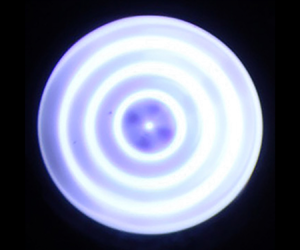Article contents
Viscoelastic effects in circular edge waves
Published online by Cambridge University Press: 25 May 2021
Abstract

Surface waves are excited at the boundary of a mechanically vibrated cylindrical container and are referred to as edge waves. Resonant waves are considered, which are formed by a travelling wave formed at the edge and constructively interfering with its centre reflection. These waves exhibit an axisymmetric spatial structure defined by the mode number  $n$. Viscoelastic effects are investigated using two materials with tunable properties; (i) glycerol/water mixtures (viscosity) and (ii) agarose gels (elasticity). Long-exposure white-light imaging is used to quantify the magnitude of the wave slope from which frequency-response diagrams are obtained via frequency sweeps. Resonance peaks and bandwidths are identified. These results show that for a given
$n$. Viscoelastic effects are investigated using two materials with tunable properties; (i) glycerol/water mixtures (viscosity) and (ii) agarose gels (elasticity). Long-exposure white-light imaging is used to quantify the magnitude of the wave slope from which frequency-response diagrams are obtained via frequency sweeps. Resonance peaks and bandwidths are identified. These results show that for a given  $n$, the resonance frequency decreases with viscosity and increases with elasticity. The amplitude of the resonance peaks are much lower for gels and decrease further with mode number, indicating that much larger driving amplitudes are needed to overcome the elasticity and excite edge waves. The natural frequencies for a viscoelastic fluid in a cylindrical container with a pinned contact-line are computed from a theoretical model that depends upon the dimensionless Ohnesorge number
$n$, the resonance frequency decreases with viscosity and increases with elasticity. The amplitude of the resonance peaks are much lower for gels and decrease further with mode number, indicating that much larger driving amplitudes are needed to overcome the elasticity and excite edge waves. The natural frequencies for a viscoelastic fluid in a cylindrical container with a pinned contact-line are computed from a theoretical model that depends upon the dimensionless Ohnesorge number  ${Oh}$, elastocapillary number
${Oh}$, elastocapillary number  ${Ec}$ and Bond number
${Ec}$ and Bond number  ${Bo}$. All show good agreement with experimental observations. The eigenvalue problem is equivalent to the classic damped-driven oscillator model on linear operators with viscosity appearing as a damping force and elasticity and surface tension as restorative forces, consistent with our physical interpretation of these viscoelastic effects.
${Bo}$. All show good agreement with experimental observations. The eigenvalue problem is equivalent to the classic damped-driven oscillator model on linear operators with viscosity appearing as a damping force and elasticity and surface tension as restorative forces, consistent with our physical interpretation of these viscoelastic effects.
- Type
- JFM Papers
- Information
- Copyright
- © The Author(s), 2021. Published by Cambridge University Press
References
REFERENCES
- 4
- Cited by



